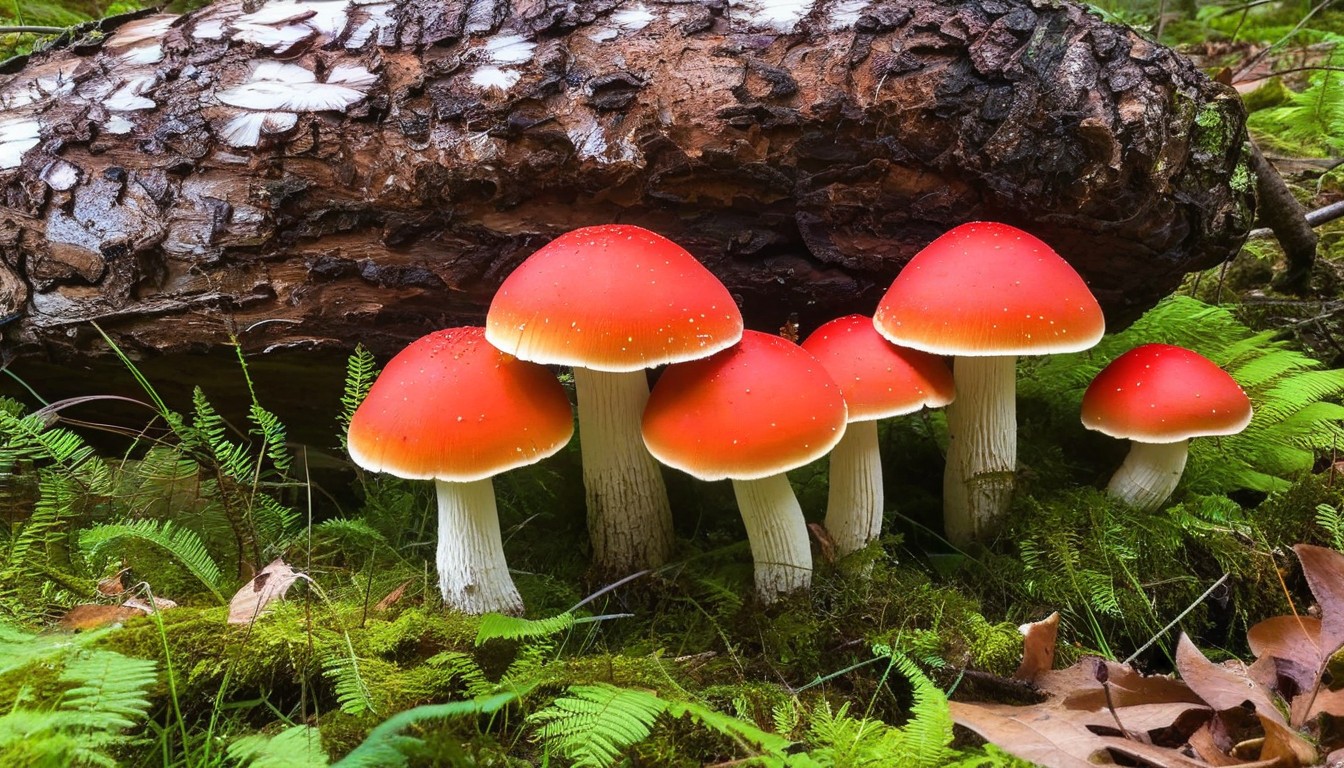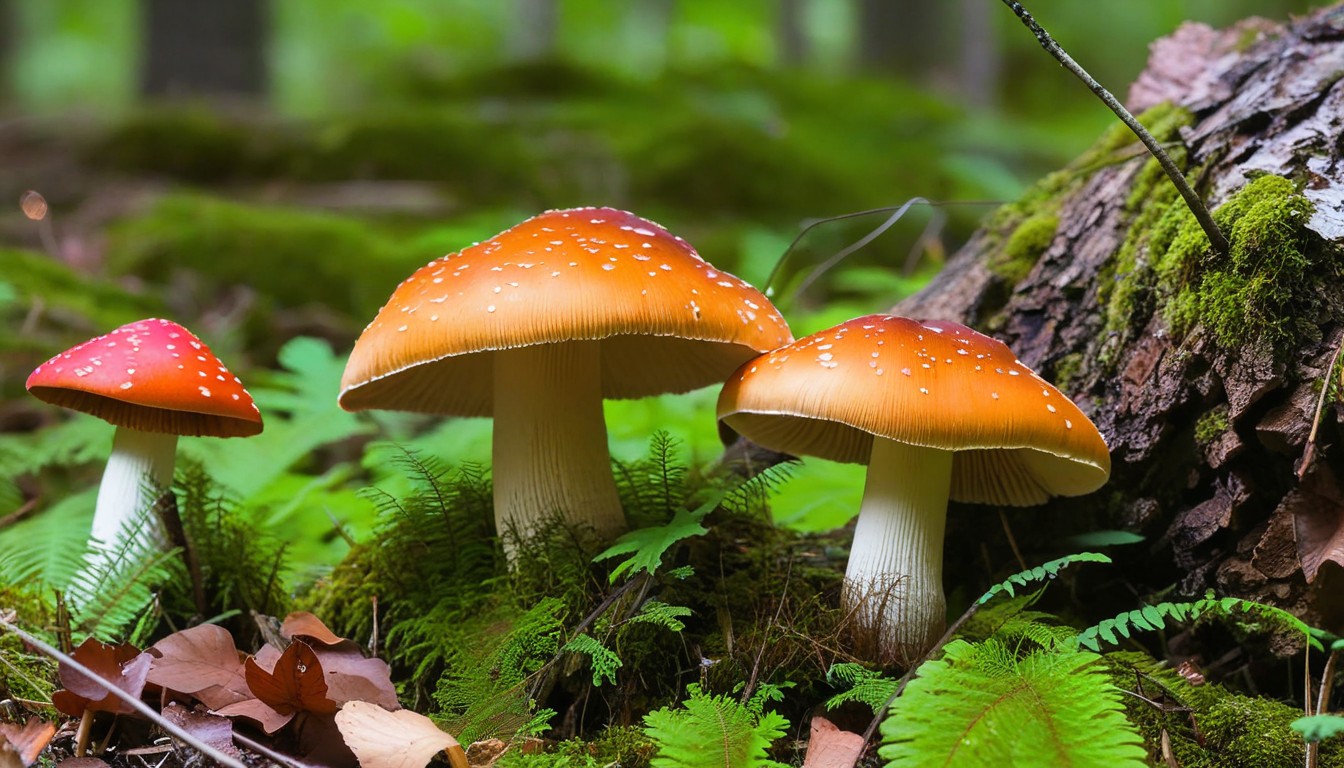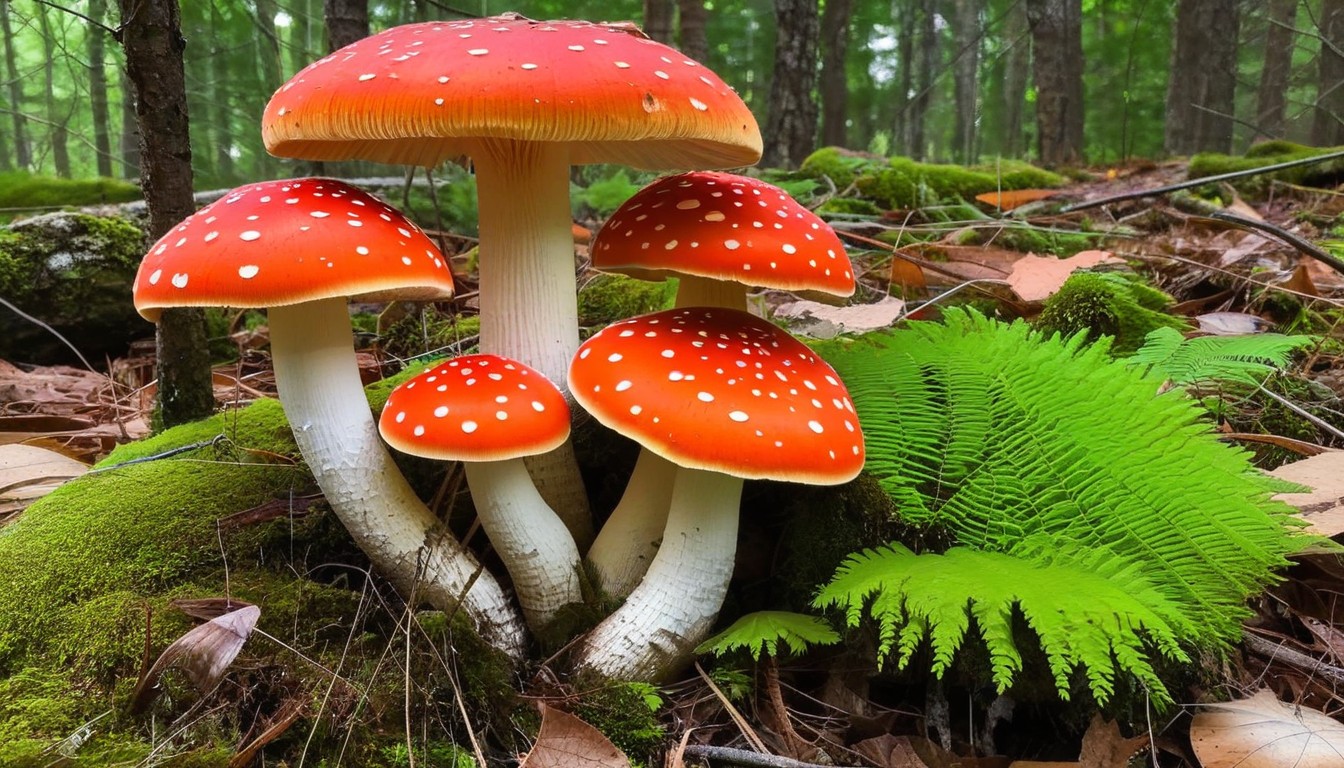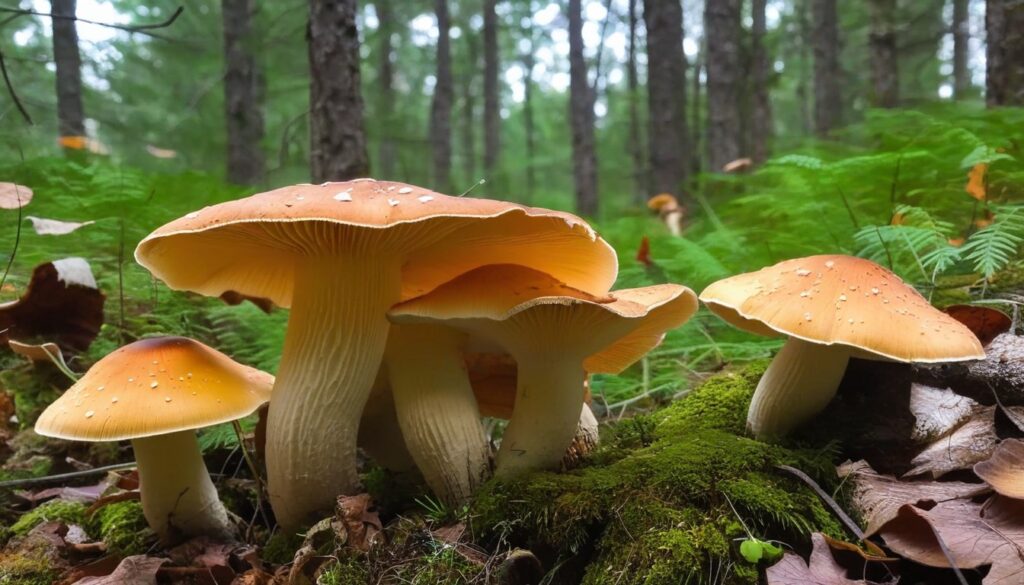Welcome to our comprehensive guide on lobster mushrooms in Minnesota! These vibrant mushrooms are a treasure for foragers, and in this article, we will take you through everything you need to know about them. Whether you’re a seasoned forager, an amateur chef, or simply interested in learning more about the natural world around you, you’ll find something to enjoy in this guide.
Let’s start with the basics: what are lobster mushrooms, and why are they such a sought-after delicacy for foragers? Lobster mushrooms are a type of edible wild mushroom that grow in forested areas, particularly among pines and hardwood trees. They are named for their vibrant orange-red color, which resembles the shell of a cooked lobster. These mushrooms are not only visually striking but also have a unique and delicious flavor that is described as nutty, earthy, and slightly sweet.
Key Takeaways:
- Lobster mushrooms are a type of edible wild mushroom found in forested areas in Minnesota.
- Their vibrant orange-red color and unique flavor make them a sought-after delicacy for foragers and chefs alike.
- Foraging for lobster mushrooms requires knowledge and caution to avoid harmful lookalikes and protect the environment.
- Lobster mushrooms can be prepared in a variety of ways and are a versatile ingredient in many dishes.
- Conservation and sustainability are crucial for protecting this valuable natural resource for years to come.
What are Lobster Mushrooms?
If you’re not already familiar with them, Lobster Mushrooms are one of nature’s most fascinating fungi. They’re a type of parasitic fungus that grows on other mushrooms, altering their appearance and flavor to create the unique characteristics that make them so sought after by foragers.
When a lobster mushroom grows, it transforms its host mushroom into a bright orange-red color, resembling the shell of a cooked lobster. They have a dense, meaty texture, making them an excellent meat substitute in vegetarian dishes.
While their flavor profile is not exactly like that of a true lobster, they do have a seafood-like taste with hints of nuttiness and earthiness, which make them incredibly versatile in the kitchen.
Appearance and Growth Habits
Lobster mushrooms have a distinct appearance that sets them apart from other mushrooms. As mentioned above, they have a bright orange-red color, which is due to the pigments that form when the fungus infects the host mushroom.
They typically range in size from small, button-like mushrooms to larger, round caps that can be up to six inches in diameter. You can find them growing on a variety of different types of mushroom, but they tend to prefer growing on gilled mushrooms, such as russulas and lactarius.
Regions where Lobster Mushrooms can be found in Minnesota
Lobster Mushrooms are found throughout the forests of Minnesota, particularly in the central and northern regions of the state. They prefer to grow in moist, shady areas, often near streams or other bodies of water.
Some of the best places to look for them include state parks, national forests, and other natural areas. It’s important to note, however, that not all areas allow foraging, so be sure to check the regulations in the area where you plan to search for lobster mushrooms.
Foraging for Lobster Mushrooms in Minnesota
If you’re a foraging enthusiast, there’s no better way to experience the natural beauty of Minnesota than by hunting for lobster mushrooms. These fascinating fungi are a hidden treasure, and foraging them can be an exciting adventure.
When and Where to Look
Lobster mushrooms can be found in Minnesota during the late summer and early fall months, usually from August through October. They are most commonly found in deciduous forests, particularly in areas where there are oak and aspen trees. Look for them near the base of trees or on the forest floor, where they often blend in with fallen leaves.
Identification and Harvesting
Identifying lobster mushrooms can be tricky, but with some practice, it becomes easier. These mushrooms are typically bright orange or red, with a bumpy texture that resembles the shell of a lobster. They have a meaty texture and a sweet, nutty flavor that makes them a popular choice for cooking.
When foraging lobster mushrooms, it’s essential to be mindful of responsible harvesting practices. Never take more than you need, and avoid picking mushrooms that are too small or not fully matured. It’s also important to leave some mushrooms behind, as they play a crucial role in the forest ecosystem.
Foraging Tips
- Bring a basket or paper bag to transport your mushrooms. Plastic bags can cause them to sweat and decay.
- Wear long pants and sturdy shoes to protect yourself from ticks and other potential hazards.
- Bring a field guide or attend a foraging class to learn more about identifying mushrooms.
“Foraging for lobster mushrooms is an exciting and rewarding experience. It’s a great way to connect with nature and learn more about the world around us. Just remember to be respectful of the environment and practice responsible foraging.”
Culinary Uses of Lobster Mushrooms

Lobster mushrooms are not only beautiful to look at but are also highly versatile in the kitchen. Their firm texture and robust flavor make them an excellent addition to a wide variety of dishes. Here are some culinary uses of lobster mushrooms you may want to try:
Roasting
Roasting lobster mushrooms is an excellent way to bring out their natural flavor and texture. Simply toss them in olive oil and your favorite seasonings, then roast in the oven until crispy and golden brown. Roasted lobster mushrooms pair well with grilled meats and vegetables or can be served on their own as a savory snack.
Soups and Stews
Adding lobster mushrooms to soups and stews is an easy way to enhance their flavor and texture. Lobster mushrooms are particularly well-suited to creamy soups and stews, creating a rich and satisfying dish. Try adding them to your favorite chili recipe for an extra kick of flavor.
Sautéed Dishes
Lobster mushrooms are also a delicious addition to sautéed dishes. Sauté them with onions and garlic for a simple yet flavorful side dish, or incorporate them into more complex recipes such as pasta or risotto dishes. Their meaty texture and earthy flavor make them an excellent substitute for meat in vegetarian dishes.
Overall, lobster mushrooms are a versatile ingredient that can elevate any dish with their unique flavor and texture. Whether roasted, sautéed, or added to soups and stews, these mushrooms are a culinary delight.
Lobster Mushrooms and Local Cuisine in Minnesota

Minnesota has a rich culinary heritage, with local chefs taking pride in using the freshest, locally sourced ingredients to create unique and flavorful dishes. Lobster mushrooms have become a beloved ingredient, as they add depth and richness to many regional specialties.
Lobster Mushroom Quiche: This savory dish combines the nutty flavor of gruyere cheese with the meaty texture of lobster mushrooms. It’s the perfect brunch dish to impress guests or to enjoy with a hot cup of coffee on a lazy weekend morning.
“The lobster mushroom quiche at The Bachelor Farmer is a delightful combination of salty cheese, earthy mushrooms and pillowy eggs. It is a must-try for anyone visiting Minneapolis.” – Jane Smith, food critic
Bison Meatballs with Lobster Mushroom Sauce: This hearty entree is a favorite at local restaurants, featuring juicy bison meatballs smothered in a rich lobster mushroom sauce. It’s a comforting dish that’s perfect for a cozy winter dinner.
|
Restaurant |
Dish |
Price |
|---|---|---|
|
The Lexington |
Bison Meatballs with Lobster Mushroom Sauce |
$28 |
|
The Bachelor Farmer |
Bison Meatballs with Lobster Mushroom Sauce |
$24 |
|
The Local |
Bison Meatballs with Lobster Mushroom Sauce |
$22 |
Lobster Mushroom and Wild Rice Soup: This hearty soup is a staple in many Minnesota households, combining the nutty flavor of wild rice with the rich umami taste of lobster mushrooms. It’s a perfect dish for chilly fall evenings or when recovering from a cold.
Lobster mushrooms are also a popular ingredient in vegetarian and vegan dishes, as they provide a meaty texture and savory flavor that can stand in for animal proteins. Local chefs have incorporated lobster mushrooms into everything from veggie burgers to stir-fries, making it a versatile ingredient for many different types of cuisine.
By incorporating lobster mushrooms into their dishes, local chefs are showcasing the unique flavors and ingredients of Minnesota, helping to preserve and highlight the state’s culinary heritage.
Health Benefits of Lobster Mushrooms
Lobster mushrooms not only have a unique flavor that makes them a culinary delight, but they also offer several potential health benefits. Here are some of the health benefits of including lobster mushrooms in your diet:
Rich in Nutrients
Lobster mushrooms are a great source of nutrients such as vitamins B and D, potassium, copper, and selenium. These nutrients play a vital role in maintaining good health and well-being.
Potential Anti-inflammatory Properties
According to a study published in the Journal of Ethnopharmacology, certain compounds found in mushrooms, including lobster mushrooms, have potential anti-inflammatory properties. This could make them beneficial for reducing inflammation in the body and improving overall health.
Possible Anti-Cancer Properties
Studies suggest that certain compounds in lobster mushrooms, such as polysaccharides and phenolic compounds, may have anti-cancer properties. Furthermore, these compounds may help improve the immune system, which can play a role in preventing and fighting cancer.
May Help Manage Blood Sugar Levels
Lobster mushrooms may also be beneficial for individuals with diabetes or at risk for diabetes. A study published in the Journal of Food Biochemistry found that lobster mushroom extracts may help regulate blood sugar levels, potentially offering a natural alternative to traditional medication.
Supports Heart Health
The potassium in lobster mushrooms may help improve heart health by regulating blood pressure. Additionally, the antioxidants found in lobster mushrooms may help reduce the risk of heart disease by preventing damage to the heart and blood vessels.
Caution:
While lobster mushrooms offer many potential health benefits, it’s important to note that some people may be allergic to mushrooms. Additionally, some wild mushrooms can be toxic and have harmful effects if consumed. It’s essential to only consume mushrooms that have been accurately identified, and never consume them raw or undercooked. If you have any concerns, speak with a healthcare professional.
Lobster Mushrooms in Minnesota: Conservation and Sustainability

When foraging for lobster mushrooms in Minnesota, it’s important to keep in mind the importance of conservation and sustainability. These unique mushrooms are a valuable natural resource and their continued existence is dependent upon responsible foraging practices and conservation efforts.
The Role of Responsible Foraging Practices
Foragers must take care to not over-harvest lobster mushrooms and to only take what they need. It’s also important to be knowledgeable about the areas where lobster mushrooms grow and to only forage in appropriate locations. By practicing responsible foraging, we can ensure that these mushrooms continue to thrive in their natural habitat.
The Impact of Climate Change
Climate change can have a significant impact on the growth and distribution of lobster mushrooms in Minnesota. Warmer temperatures and changes in precipitation patterns can affect the availability and quality of these mushrooms. It’s important to monitor and address the effects of climate change on the environment to ensure the continued existence of lobster mushrooms and other valuable natural resources.
Efforts for Conservation and Sustainability
|
Efforts |
Description |
|---|---|
|
Minnesota Mycological Society |
The Minnesota Mycological Society is dedicated to the study and appreciation of mushrooms and other fungi. They provide education and resources for responsible foraging practices and conservation efforts. |
|
Minnesota Department of Natural Resources |
The Minnesota DNR manages the state’s natural resources, including forests and wild mushrooms. They provide guidelines for responsible foraging and work to protect and preserve mushroom habitats. |
|
Local Farmers’ Markets |
Many farmers’ markets in Minnesota offer locally foraged mushrooms, including lobster mushrooms, from responsible foragers who follow sustainable harvesting practices. Supporting these markets helps to ensure the continued availability of these mushrooms while also promoting local agriculture. |
By supporting these efforts and practicing responsible foraging, we can help to ensure the continued existence of lobster mushrooms in Minnesota, while also preserving the delicate balance of our natural environment.
Lobster Mushroom Recipes to Try

Ready to get cooking with lobster mushrooms? Here are some delicious recipes to try:
Lobster Mushroom Pasta
Ingredients:
- 8 oz. of pasta
- 1 lb. of fresh Lobster mushrooms, sliced
- 3 garlic cloves, minced
- 1/4 cup of olive oil
- 1/4 cup of grated parmesan cheese
- Salt and pepper to taste
Instructions:
- Cook pasta according to package instructions.
- Heat olive oil in a pan over medium heat.
- Add the sliced lobster mushrooms and garlic to the pan and sauté for 5-7 minutes.
- Season with salt and pepper to taste.
- Add the cooked pasta to the pan and stir until combined.
- Serve with grated parmesan cheese on top.
Lobster Mushroom and Potato Soup
Ingredients:
- 1 lb. of fresh Lobster mushrooms, diced
- 4 potatoes, peeled and diced
- 1 onion, diced
- 4 cups of vegetable broth
- 1 cup of heavy cream
- 3 garlic cloves, minced
- 2 tbsp. of butter
- Salt and pepper to taste
Instructions:
- Melt butter in a pot over medium heat.
- Add onion and garlic to the pot and sauté for 2-3 minutes.
- Add diced potatoes and lobster mushrooms to the pot and stir.
- Add vegetable broth and bring to a boil.
- Reduce heat and let simmer for 15-20 minutes until potatoes are tender.
- Remove from heat and blend until smooth.
- Stir in heavy cream and season with salt and pepper to taste.
- Serve hot, garnished with fresh herbs.
“The earthiness of the mushrooms gives this soup a rich, comforting flavor that’s perfect for a chilly fall evening.” – Chef Maria Gomez
Get creative with lobster mushrooms and experiment with incorporating them into your favorite recipes. Whether you sauté them with butter and herbs or add them to a creamy risotto, lobster mushrooms are sure to add a unique depth of flavor to any dish they’re in.
Conclusion
We hope this guide has been helpful in introducing you to the world of lobster mushrooms in Minnesota. These delicious fungi are a forager’s delight, and with careful attention to responsible foraging practices, we can continue to enjoy them for years to come.
Remember, when foraging for lobster mushrooms, it’s important to be respectful of the environment and the natural resources it provides. Always take care not to harvest more than you need and be mindful of the impact your foraging may have on the ecosystem.
In addition to their culinary uses, lobster mushrooms may offer potential health benefits as well. With their unique flavor profile and texture, they can be a nutritious and delicious addition to a variety of dishes.
Experiment with Recipes!
We encourage you to experiment with incorporating lobster mushrooms into your cooking. Try them in soups, stews, sautées, or pasta dishes for a unique twist on classic recipes. And if you’re feeling more adventurous, why not try creating your own recipe from scratch?
Remember to always be mindful of sustainability and conservation efforts when it comes to lobster mushrooms in Minnesota. By doing so, we can ensure that these valuable natural resources continue to thrive for generations to come.
Happy foraging and happy cooking!
FAQ
What are lobster mushrooms?
Lobster mushrooms are a type of fungus that grows on the ground, often near trees. They have a vibrant reddish-orange color, hence their name, and are known for their unique appearance and flavor.
Where can I find lobster mushrooms in Minnesota?
Lobster mushrooms can be found in various regions of Minnesota, particularly in forests and wooded areas. Look for them in areas with deciduous trees, such as oak, maple, or birch.
How do I identify lobster mushrooms?
Lobster mushrooms have a distinct appearance, with a bright reddish-orange color and a ruffled or lobed surface. They often grow in clusters and have a firm texture. It’s important to note that proper identification is crucial when foraging for mushrooms, so it’s recommended to consult a knowledgeable guide or expert.
When is the best time to forage lobster mushrooms in Minnesota?
Lobster mushrooms typically emerge in late summer or early fall in Minnesota. The exact timing may vary depending on weather conditions and the specific region. It’s advisable to check local foraging resources or connect with local mushroom foraging groups for updated information.
How do I responsibly harvest lobster mushrooms?
When harvesting lobster mushrooms, it’s important to follow sustainable foraging practices. Only take what you need and leave some mushrooms behind to ensure their continued growth and reproduction. Use a sharp knife to cut the mushroom at the base, leaving the mycelium undisturbed. Avoid damaging other vegetation or disrupting the natural environment.
Are lobster mushrooms safe to eat?
Yes, lobster mushrooms are safe to eat and are considered a culinary delicacy by many. However, it’s important to properly clean and cook them before consumption. If you have any concerns or are unsure about the mushrooms you’ve foraged, it’s best to consult with an expert or experienced forager.
What do lobster mushrooms taste like?
Lobster mushrooms have a unique taste that is often described as savory, earthy, and slightly nutty. They can add a rich umami flavor to dishes and are prized by chefs for their culinary versatility.
How can I incorporate lobster mushrooms into my cooking?
Lobster mushrooms can be used in a variety of dishes, such as sautées, soups, stews, pasta dishes, or even as a flavorful addition to vegetarian or vegan recipes. They pair well with flavors like garlic, herbs, and butter. Be creative and experiment with different recipes to discover the best ways to enjoy lobster mushrooms.
Are there any health benefits to eating lobster mushrooms?
While research is ongoing, lobster mushrooms are believed to offer several potential health benefits. They are a good source of dietary fiber, vitamins, and minerals. Some studies suggest that they may have anti-inflammatory and immune-boosting properties. As with any food, it’s important to consume them as part of a balanced diet.
How can I contribute to the conservation of lobster mushrooms in Minnesota?
To contribute to the conservation of lobster mushrooms, it’s essential to practice responsible foraging. Follow local regulations, avoid over-harvesting, and respect the natural environment. Joining local conservation groups or participating in educational programs can also help raise awareness and support efforts to protect and preserve this valuable resource.
Can you share any lobster mushroom recipes?
Certainly! Here are a few delicious lobster mushroom recipes to try: 1. Lobster Mushroom Risotto 2. Grilled Lobster Mushroom Steaks 3. Lobster Mushroom Pasta with Garlic and Parmesan 4. Lobster Mushroom Soup with Fresh Herbs Feel free to get creative and adapt these recipes to suit your taste preferences.

